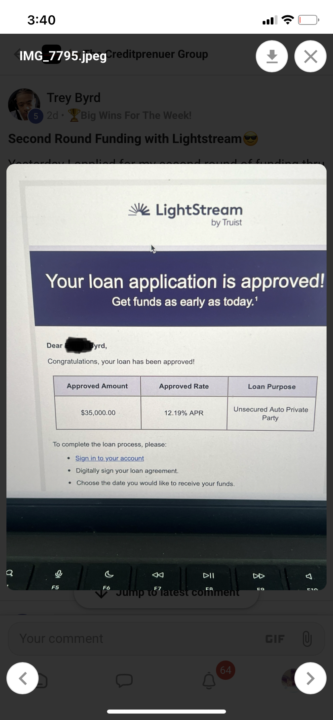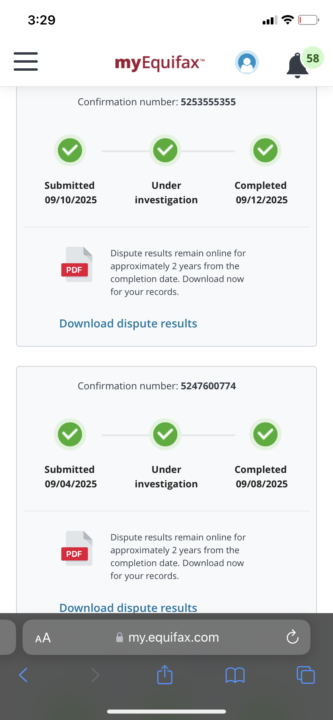Activity
Mon
Wed
Fri
Sun
Jan
Feb
Mar
Apr
May
Jun
Jul
Aug
Sep
Oct
Nov
Dec
What is this?
Less
More
Owned by Devante
Tired Of Being Denied The Lifestyle You Want ? Come Join A Community That Will Guide You Right To The Doorsteps Of Financial Freedom📈🎓
Memberships
(Free)Credit Repair Made Easy
2.2k members • Free
20 contributions to ProfitOffCredit University
Lightstream autoloan 35k
MOST BANKS, WHEN THEY APPROVE AUTO LOANS, DONT PUT THE MONEY DIRECTLY IN THE HANDS OF THE CONSUMER BUT I GOT 1 THAT DO!!! AND THEY DEPOSIT THE MONEY DIRECTLY INTO YOUR ACCOUNT -AUTO LOANS TYPICALLY ARE THE EASIEST TYPE OF CREDIT TO GET APPROVED FOR SO YOU GET APPROVED FOR HIGHER AMOUNTS THAN YOU WOULLD ON A PERSONAL LOAN OR CREDIT CARD LIGHTSTREAM.COM DATA POINTS: -PULLS FROM TRANSUNION -700+ CREDIT SCORE -2+ YRS CREDIT AGE -100% PAYMENT HISTORY -8+ ACCOUNTS -3 OR LESS INQUIRIES -NO DEROGATORY OR COLLECTION ACCOUNTS ****DONT GO OVER 35K FOR THE ASKING AMOUNT
0
0

2 phone deletions
2 phone accounts deleted I disputed directly with Equifax pointing out different errors and violations of my FCRA laws like not reporting a “Date of first delinquency” which is a violation to 15 U.S. Code 1681i - failure to report accurate and verifiable information All collection accounts must contain “date of first delinquency
0
0

American Express Relationship Hack
🚨How to get that Amex relationship for just $1🚨 If you don't already have a relationship with American Express you can get in with them for as little as $1. All you have to do is open a high yield savings account with them! Here is the beauty of these accounts: ✅NO MINNIMUM BALANCE to open the account ✅NO MINNIMUM BALANCE to maintain the account. ✅Get up to 3.60% APY on your money ✅Build a strong relationship with Amex even BEFORE you get your credit cleaned up That's right fam, I guess really for a little as $0.01 you get in with the biggest of the big dogs, but if you want my advice I would say put as much money as you can afford into the account I would also set up some automatic deposits to go to the account, you'll also keep making a good impression on Amex every time they see money coming in. Click the link to set one up today, it's quick, and easy, and its the perfect play to run while you're getting your credit together, so that you're in even better position when it comes time to get the funding bag.

0 likes • Sep 20
@Zanae Brown you would wanna clean they credit and build a strong profile and add a tradeline or 2 before applying to maximize the amount of approval but it’s no wait time I’ll just suggest opening the savings account and put money in it every week for at least a month or 2 to build a relationship
AMEX HIGH YEILD SAVINGS ACCOUNT
https://www.skool.com/profitoffcredit-university-9697/american-express-relationship-hack?p=e3fa4a38
1
0
ORDER TO SEND DISPUTE LETTERS
📍Step 1: FREEZE MAIN 3 CREDIT BUREAUS (EXPERIAN, EQUIFAX, AND TRANSUNION) -FREEZE SECONDARY BUREAUS 📍Step 2: UPDATE PERSONAL INFORMATION 📍Step 3: REMOVE HARD INQUIRIES 📍Step 4: IDENTITYTHEFT SWEEP FACTUAL DISPUTING 📍Step 5: Round 1 Letter – Direct Dispute to Credit Bureaus When: Day 1 Who to Send To: - Equifax - Experian - TransUnion What to Include: - Original dispute letter (like the one we already wrote) - Copy of government ID - Proof of address (e.g., utility bill, bank statement) - Screenshot or documentation of the errors (optional but helpful) Delivery Method: Certified mail with return receipt Wait: 30 calendar days (bureaus have up to 30 days to investigate under FCRA §611) 📍Step 6: Round 2 Letter – Follow-Up / Escalation When: Day 31–35 (after no deletion or unsatisfactory response) Who to Send To: - Same credit bureaus (Equifax, Experian, TransUnion) What to Include: - Second (round 2) letter - Copy of the first dispute letter - Mention of FCRA violations and noncompliance - Re-emphasize specific errors and demand deletion - Copy of your ID and proof of address again Wait: Another 15–30 days for a formal reply or deletion 📍Step 7: Creditor / Furnisher Direct Dispute (Optional but Recommended) When: Same time as or right after Round 2 Who to Contact: - The creditor or data furnisher (in this case, MID-ATLNTC or whoever owns the account now) What to Include: - Copy of the credit report - Explanation of inconsistencies - Same FCRA and Metro 2 issues - Demand deletion or correction from their end Why: Under FCRA §623(a)(8), they must investigate direct disputes and respond. 📍Step 8: File Complaints (If No Action Is Taken) When: Around Day 60–75, if no resolution Where to File: - CFPB: consumerfinance.gov/complaint - FTC: reportfraud.ftc.gov - State Attorney General's Office Attach: - Copies of both dispute letters - Credit reports showing the account - Mailing receipts and any response from the bureaus
0
0
1-10 of 20
@devante-wilson-7134
Profit Off Credit University: From Credit Repair to Cash Flow
Active 17h ago
Joined Jun 27, 2025

